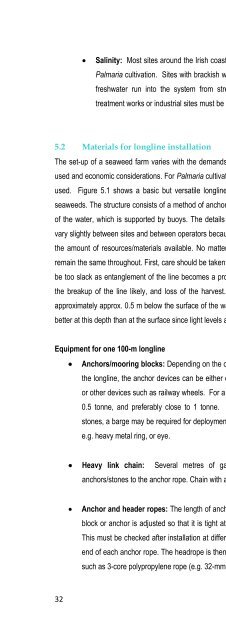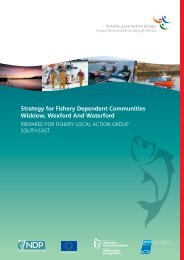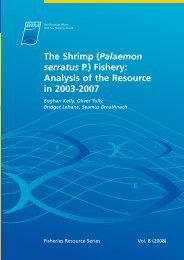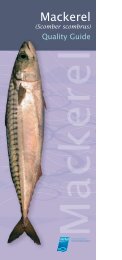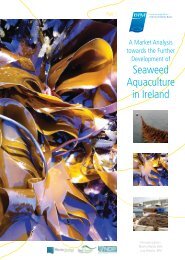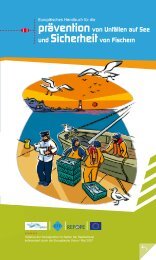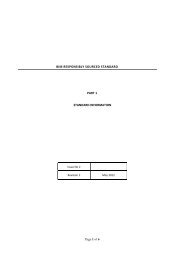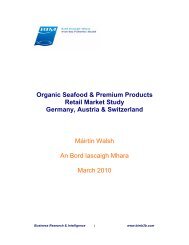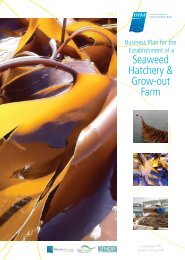Cultivating Palmaria palmata - Bord Iascaigh Mhara
Cultivating Palmaria palmata - Bord Iascaigh Mhara
Cultivating Palmaria palmata - Bord Iascaigh Mhara
You also want an ePaper? Increase the reach of your titles
YUMPU automatically turns print PDFs into web optimized ePapers that Google loves.
32<br />
Salinity: Most sites around the Irish coastline will experience full salinity and are suitable sites for<br />
<strong>Palmaria</strong> cultivation. Sites with brackish water, such as estuaries or where other large volumes of<br />
freshwater run into the system from streams or rivers, as well as outflows from wastewater<br />
treatment works or industrial sites must be avoided.<br />
5.2 Materials for longline installation<br />
The set-up of a seaweed farm varies with the demands of the seaweed species, the type of seeded collectors<br />
used and economic considerations. For <strong>Palmaria</strong> cultivation at sea, a single-header longline structure is currently<br />
used. Figure 5.1 shows a basic but versatile longline construction suitable for the cultivation of a range of<br />
seaweeds. The structure consists of a method of anchorage, connected to a header rope on or near the surface<br />
of the water, which is supported by buoys. The details of the equipment are outlined below, but longlines can<br />
vary slightly between sites and between operators because of different challenges in the deployment, and also in<br />
the amount of resources/materials available. No matter how the longline is constructed, two elements should<br />
remain the same throughout. First, care should be taken over the tensioning of the header rope – this must never<br />
be too slack as entanglement of the line becomes a problem. If it is too tight, however, rubbing can occur, with<br />
the breakup of the line likely, and loss of the harvest. Second, the header rope must always be positioned<br />
approximately approx. 0.5 m below the surface of the water. This is necessary as <strong>Palmaria</strong> develops and grows<br />
better at this depth than at the surface since light levels are lower here and bleaching is less likely.<br />
Equipment for one 100-m longline<br />
Anchors/mooring blocks: Depending on the current at the site, the bottom substrate and the length of<br />
the longline, the anchor devices can be either concrete anchor stones of suitable size, plough anchors<br />
or other devices such as railway wheels. For a 100-m longline, the anchor stones should weigh at least<br />
0.5 tonne, and preferably close to 1 tonne. Depending on the size, weight and number of anchor<br />
stones, a barge may be required for deployment. Some method of attachment is required on the stone,<br />
e.g. heavy metal ring, or eye.<br />
Heavy link chain: Several metres of galvanised heavy-duty chain are required to connect<br />
anchors/stones to the anchor rope. Chain with at least 16-20 cm links is suggested for use.<br />
Anchor and header ropes: The length of anchor rope which is attached to the chain from the mooring<br />
block or anchor is adjusted so that it is tight at high water without allowing too much slack at low tide.<br />
This must be checked after installation at different states of the tide. A marker buoy is attached to the<br />
end of each anchor rope. The headrope is then installed between the two marker buoys. Durable ropes<br />
such as 3-core polypropylene rope (e.g. 32-mm for mooring, 16-mm for headrope) should be used.


